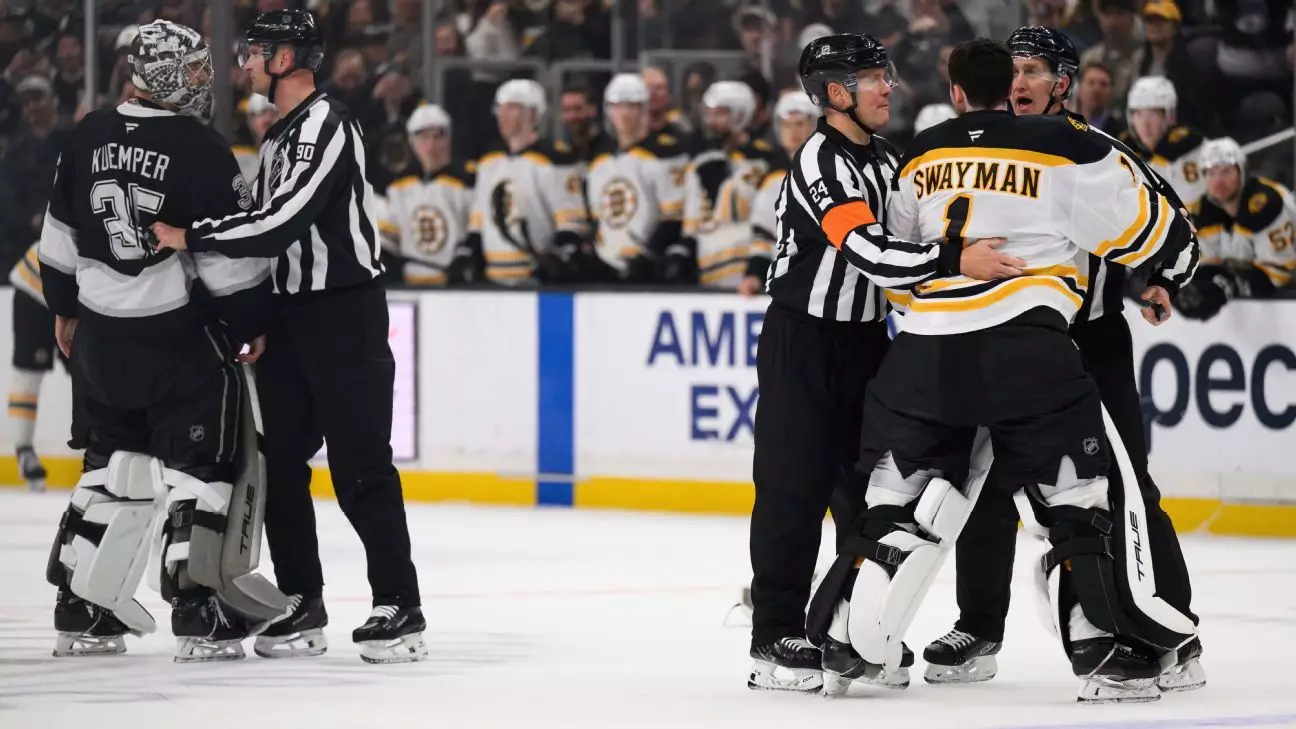In the thrilling atmosphere of an NHL game, the potential for a spontaneous fight between goalies can electrify a crowd and send shockwaves through the stands. This past Sunday, during a highly anticipated matchup between the Los Angeles Kings and the Boston Bruins, fans were almost treated to such an event. Goalie Darcy Kuemper, representing the Kings, and his Bruins counterpart Jeremy Swayman found themselves on a collision course of heated emotions late in the second period. As the tension mounted, Kings coach Jim Hiller’s instincts kicked in; the terrifying prospect of key players getting injured momentarily overshadowed the excitement of a possible brawl.
The Interplay of Instincts and Strategy
Highlighting the fraught nature of this situation, Hiller frowned upon the theatrics that might have followed an all-out melee. “I mean, nobody wants to see that,” he remarked, although he quickly tempered his honesty with the revelation that hockey purists might secretly relish these confrontations. Nonetheless, a smart coach prioritizes team integrity over frivolous bravado, and Hiller’s reluctance to allow his star goalie to risk injury speaks volumes about his leadership style.
These moments raise intriguing questions about the unsaid rules of the game. The instinctual fight-or-flight response seen in players during high-stakes scenarios can unravel professionalism momentarily. Curiously, the adrenaline-fueled competitive spirit can blur lines between aggression and strategy, revitalizing the age-old debate about player safety versus entertainment.
The Triggering Incident: Interference and Retaliation
The near-altercation stirred from a play that seemed innocuous but erupted with layers of complexity. It began when Bruins forward Marat Khusnutdinov collided with Kuemper after being pushed from behind by Tanner Jeannot of the Kings, resulting in a goaltender interference call. This moment of apparent chaos escalated rapidly, with Kuemper exhibiting a forceful display of authority as he retaliated against Khusnutdinov, setting the stage for Swayman’s intervention.
Swayman’s invitation to Kuemper for a face-off exemplified the unwritten, often romanticized camaraderie among players—an acknowledgment that they stand firm in defense of their teammates. It wasn’t just a simple retaliation; it represented an emblematic clash of pride, one that could either forge bonds or breed animosity. In that confined space on the rink, a swirling mass of egos collided, and the spectators were left yearning for a more visceral spectacle of sport.
The Referee’s Role: Guardians of the Game
As this gripping moment unfolded, the unwavering vigilance of referees Graham Skilliter and linesman Travis Toomey played a crucial role. Their adept intervention not only mitigated a potentially damaging physical confrontation but also illustrated a profound understanding of the game’s dynamics. By stepping in and restraining the goalies, they functioned as the silent guardians of the game, ensuring that the integrity of hockey remained intact. For Hiller, the safeguarding of his players was paramount, especially with Kuemper enjoying a remarkable home streak, never losing in regulation over fourteen games.
Such vigilance might not always be celebrated by fans craving for that raw, unfiltered clash, yet it forms the backbone of a rapidly evolving sport that seeks to balance tradition with safety. The referees’ quick response also reflects an understanding of the players’ varying capabilities; goalies are often seen as less agile than their skater counterparts, making them more vulnerable to injuries in scrums.
Fans’ Emotions: A Double-Edged Sword
While the game unfolded without the overt carnage fans had hoped to witness, the palpable disappointment echoed throughout the arena and social media platforms. A captive audience yearned for a break from the norm, an injection of raw emotion that can significantly alter the dynamic of the game. Whether one views fighting in hockey as a relic of the past or an essential aspect of the sport, the crowd’s appetite for drama cannot be ignored.
Given the NHL’s recent trend of scaling back on fights—perhaps due to a renewed focus on player health—one must consider whether the fervor for these moments has increased or diminished among fans. As Swayman himself articulated, the emotions are very much intertwined in these instances. They’re “heated moments,” a description that highlights the raw passion behind hockey, transcending the game to reveal its deeper emotional currents.
In this way, the nearly ignited confrontation serves as a unique indictment of the multifaceted nature of hockey: where the delicate balance of aggression, strategy, and safety persistently shapes the on-ice experience. Fans might have missed a spectacle, but the layers of emotional and strategic complexity provide their own nuanced drama—one that deserves recognition beyond sheer physicality.


Leave a Reply